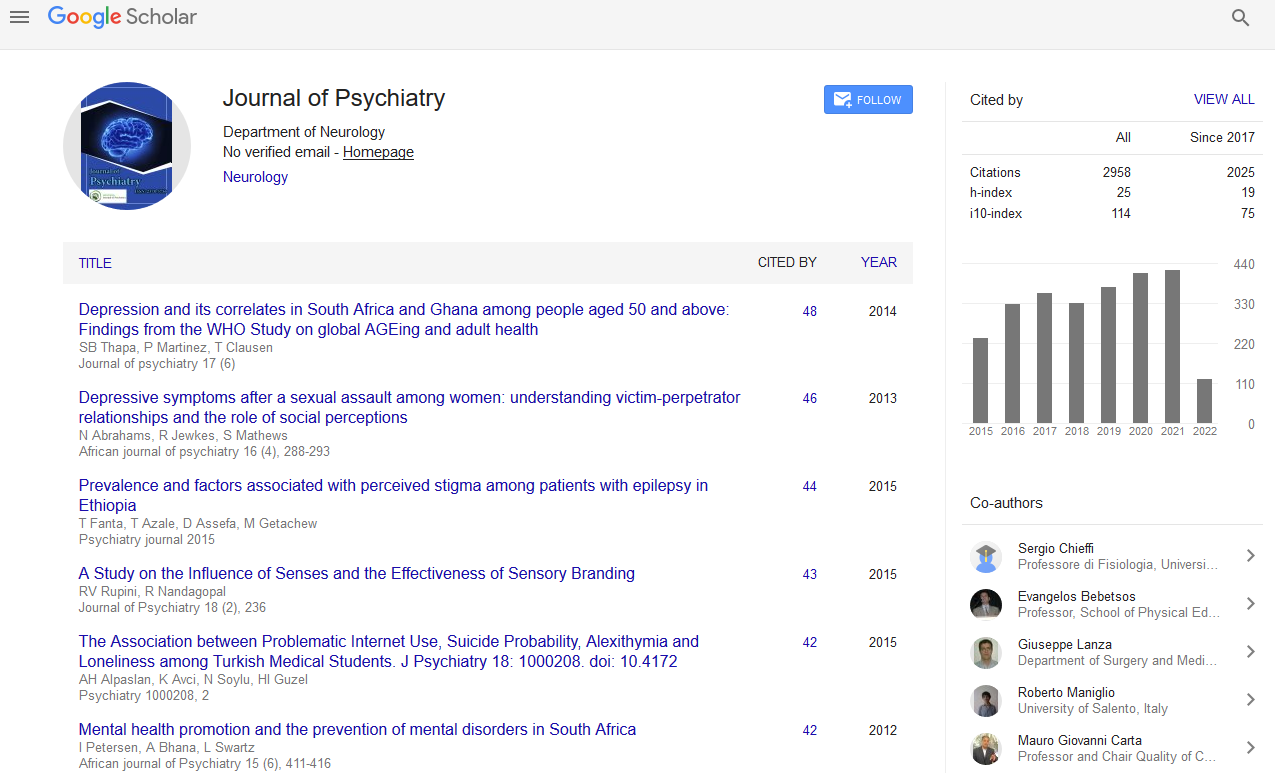PMC/PubMed Indexed Articles
Indexed In
- RefSeek
- Hamdard University
- EBSCO A-Z
- OCLC- WorldCat
- SWB online catalog
- Publons
- International committee of medical journals editors (ICMJE)
- Geneva Foundation for Medical Education and Research
Useful Links
Share This Page
Open Access Journals
- Agri and Aquaculture
- Biochemistry
- Bioinformatics & Systems Biology
- Business & Management
- Chemistry
- Clinical Sciences
- Engineering
- Food & Nutrition
- General Science
- Genetics & Molecular Biology
- Immunology & Microbiology
- Medical Sciences
- Neuroscience & Psychology
- Nursing & Health Care
- Pharmaceutical Sciences
Nature, nurture and their influence over children with suicidal and/or homicidal thoughts
19th Global Congress on Pediatricians & Child Psychiatry
July 12-13, 2017 Chicago, USA
Kasia Wereszczynska
University of St Francis, USA
Scientific Tracks Abstracts: J Psychiatry
Abstract:
Though childhood suicide and homicide rates have fluctuated historically, trends have noted a steady continual increase. A study published in the US Centers for Disease Control and Prevention's (2014) Morbidity and Mortality Weekly Report revealed that childhood suicide rates fluctuated between 1999 and 2007 but increased significantly from 2007 through 2014 with the number doubling from 0.9 per 100,000 to 2.1, totaling 425 deaths. Further, the Office of Juvenile Justice and Delinquency Prevention (2014) revealed that �??Between 1980 and 2014, the estimated proportion of murders involving a juvenile offender acting alone gradually declined, from 66% in the 1980s, to 59% in the 1990s, to 50% in the last 10 years. Comparatively, the proportion of murders committed by juveniles and adults increased from 25% in the 1980s to 41% in the last 10 years�?�. And the debate continues. Does nature or nurture more significantly influence childhood? Although there are arguments that may lean in greater favor toward one direction or the other, recent research has demonstrated relative equivalence�??particularly alongside the occurrence of more severe distress leading toward homicidal or suicidal ideation and follow-through. As explained by the National Academic Press (2002), �??Since the heritability of liability to suicidal behaviors appears to be on the order of 30-50 percent, family-environmental causes for suicidal behavior, such as abuse, must also be considered, as both independent factors and those that may interact with genetic vulnerability�?�. Factors leading toward homicidal and suicidal behavior are highly individualized and diverse. All things being equal, nature or nurture may persevere in influence upon the child; however, influential genetic factors in combination with adverse familial environments pose significant risk. Therefore, to be most effective, counselors must be aware of these conditions and how to most appropriately treat the child client across both conditions.
Biography :
Kasia Wereszczynska, MA, LCPC, RYT has an extensive training and 15+ years’ experience in crisis intervention, cognitive-behavioral therapy and positive psychology. She has provided counseling to a culturally diverse population serving the South Side of Chicago and the North Shore area. She has a history of working in various settings including the mental health court system, hospital emergency rooms, community mental health agencies, schools and both inpatient/outpatient psychiatric hospital settings. She is currently working in private practice with counseling speaks and has hospital privileges at Chicago Behavioral Hospital. She is the Past President of the Chicago Counseling Association (CCA), and the current President of Illinois Association of Multicultural Counseling (IAMC). She is the Founder of In Her Shoes Foundation a 501c(3) organization that brings together women of all ages and backgrounds to inspire, connect, educate and support the development and maintenance of a healthy and positive lifestyle. In addition, she teaches Psychology classes at Oakton Community College and Crisis Intervention at the University of St Francis.
Email: kasia.weresz@gmail.com


